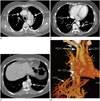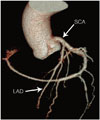Abstract
A 50-year-old woman was referred to our institution for medical screening due to an incidental finding on abdominal ultrasonography. She underwent chest, abdomen and cardiac multi-detector computed tomography (MDCT). Her MDCT revealed absence of the hepatic segment of the inferior vena cava (IVC), with hemiazygos continuation and a left single coronary artery. The dilated hemiazygos vein drained directly into the persistent left superior vena cava (SVC). Herein, we reported a very rare case combining an incidentally found interrupted IVC with hemiazygos vein continuation, persistent left SVC and a left single coronary artery diagnosed by MDCT.
Congenital intrahepatic inferior vena cava (IVC) interruption with azygos/hemiazygos continuation is a rare congenital anomaly (12) and hemiazygos vein continuation draining into the right atrium via a persistent left superior vena cava (SVC) is even rarer (3). Furthermore, a single coronary artery (SCA) ostium, in the absence of other cardiac disease, is an extremely rare coronary artery anomaly (4). We presented a very rare case of incidentally found interrupted IVC with hemiazygos vein continuation combined with a left SCA diagnosed by multi-detector computed tomography (MDCT). The dilated hemiazygos vein drained directly into the persistent left SVC.
A 50-year-old woman was referred to our institution for medical screening due to an incidental finding on abdominal ultrasonography. Ultrasonography was unable to demonstrate the hepatic segment of the IVC. She was scheduled for chest, abdomen and cardiac MDCT because she wanted whole body evaluation. On the day of admission, the patient's physical examination and electrocardiogram (ECG) were unremarkable. She reported mild chest discomfort with no other abdominal or respiratory symptoms. Her history included hypertension (diagnosed 5 years previously), for which she had been taking antihypertensive drugs for the past 5 years. There was no history of trauma, diabetes, or surgery. The patient had no connective tissue disorders or other systemic anomalies, and no significant family history of disease. A chest X-ray revealed clear lungs and a normal-sized heart. Transthoracic echocardiography revealed a dilated coronary sinus, but no other abnormalities were noted.
Initially, cardiac CT with retrospective ECG gating was performed with a 128-slice MDCT scanner (Ingenuity core 128; Philips Medical Systems, Best, the Netherlands). A 70-second delayed phase chest and abdomen CT was subsequently performed. CT scan demonstrated absence of the hepatic segment of the IVC with hemiazygos continuation; the dilated hemiazygos vein drained into the persistent left SVC (Figs. 1, 2, Supplementary Movie 1 in the online-only Data Supplement). Hepatic veins drained directly into the supra-hepatic part of the IVC and right atrium. The right SVC normally drained into the right atrium and the left SVC also drained into the right atrium through the dilated coronary sinus. The patient had no left brachiocephalic vein. A three-dimensional volume-rendering cardiac CT image showed the SCA arising from the left coronary sinus of Valsalva, and an absent right coronary artery (Fig. 3, Supplementary Movie 2 in the online-only Data Supplement). The SCA produced the anterior descending branch in the usual pattern, which then continued in the atrioventricular groove as the left circumflex branch; it traveled beyond the crux into the right atrioventricular groove, where it provided branches to the right ventricle and atrium. There were no significant atherosclerotic lesions in the coronary arteries, and the aorta and other major vascular structures were normal. MDCT contributed additional diagnostic information and confirmed the diagnosis, which remained equivocal on routine abdominal ultrasound. The patient was discharged in good condition without any medical treatment.
Interruption of the IVC with azygos/hemiazygos continuation is a rare, but well-known, anomaly (12) with a prevalence of 0.6-2.0% in patients with congenital heart disease and < 0.3% among otherwise-normal patients (2). The condition is typically described as a congenital heart malformation associated with heterotaxy (cardiosplenic) syndrome, particularly in the form of left isomerism or polysplenia (56). However, an isolated occurrence without heart disease may go unnoticed during early life and may be detected incidentally during a radiological examination or vascular interventions. Recent advances in MDCT technology have led to incidental diagnoses of IVC or other vascular anomalies.
Hemiazygos continuation draining into the right atrium via a persistent left SVC is rare (3); SCA is extremely rare, with an incidence of 0.024-0.066% in the general population undergoing coronary angiography (478). SCA may be associated with other severe congenital cardiac malformations, such as persistent truncus arteriosus, tetralogy of Fallot, and pulmonary atresia. In our case, the hemiazygos vein continued and connected to the persistent left SVC posteriorly, finally entering the right atrium via the enlarged coronary sinus. MDCT also revealed an anomalous SCA arising from the left sinus of Valsalva, together with absence of the right coronary artery. According to the classification by Lipton et al. (7) and Yamanaka and Hobbs (8), our present case can be classified as group I (L-1 subtype). According to the definition, the 'L-1' pattern implies that the right coronary artery is congenitally absent and the left circumflex artery is markedly dominant. Fortunately, there were no significant symptoms or other associated cardiac or vascular anomalies. To our knowledge, no reported case has completely matched our findings. Knowledge of the presence of an interrupted IVC, persistent left SVC, or coronary artery anomalies is important for both surgeons and radiologists to prevent problems when planning an endovascular intervention or surgery, such as coronary angiography, right heart catheterization, electrophysiological studies, cardiopulmonary bypass surgery, cardiac transplantation, femoral vein catheter advancement, IVC filter placement, or temporary pacing through the transfemoral route (269).
In summary, we reported a very rare case of an incidentally detected interrupted IVC with hemiazygos continuation combined with a left SCA. The dilated hemiazygos vein drained directly into the persistent left SVC.
Figures and Tables
Fig. 1
Axial (A-C) and three-dimensional computed tomography (D) images showing an absent hepatic segment of the inferior vena cava (IVC) with hemiazygos continuation. The dilated hemiazygos vein (HAV) drains into the persistent left superior vena cava (LSVC). The LSVC drains into the right atrium through the dilated coronary sinus (CS). Hepatic veins (HVs) form a confluence and drain directly into the right atrium via supra-hepatic IVC (SH-IVC).
RSVC = right superior vena cava

References
1. Yilmaz E, Gulcu A, Sal S, Obuz F. Interruption of the inferior vena cava with azygos/hemiazygos continuation accompanied by distinct renal vein anomalies: MRA and CT assessment. Abdom Imaging. 2003; 28:392–394.
2. Vijayvergiya R, Bhat MN, Kumar RM, Vivekanand SG, Grover A. Azygos continuation of interrupted inferior vena cava in association with sick sinus syndrome. Heart. 2005; 91:e26.
3. Yildiz AE, Cayci FS, Genc S, Cakar N, Fitoz S. Right nutcracker syndrome associated with left-sided inferior vena cava, hemiazygos continuation and persistant left superior vena cava: a rare combination. Clin Imaging. 2014; 38:340–345.
4. Desmet W, Vanhaecke J, Vrolix M, Van de Werf F, Piessens J, Willems J, et al. Isolated single coronary artery: a review of 50,000 consecutive coronary angiographies. Eur Heart J. 1992; 13:1637–1640.
5. Tubau A, Grau J, Filgueira A, Juan M, Estremera A, Ferrer MI, et al. Prenatal and postnatal imaging in isolated interruption of the inferior vena cava with azygos continuation. Prenat Diagn. 2006; 26:872–874.
6. Minniti S, Visentini S, Procacci C. Congenital anomalies of the venae cavae: embryological origin, imaging features and report of three new variants. Eur Radiol. 2002; 12:2040–2055.
7. Lipton MJ, Barry WH, Obrez I, Silverman JF, Wexler L. Isolated single coronary artery: diagnosis, angiographic classification, and clinical significance. Radiology. 1979; 130:39–47.
8. Yamanaka O, Hobbs RE. Coronary artery anomalies in 126,595 patients undergoing coronary arteriography. Cathet Cardiovasc Diagn. 1990; 21:28–40.
9. Imamura M, Abraham B, Garcia X, Knecht KR, Frazier E, Shinkawa T. New transplant technique with hemiazygos continuation and interrupted inferior vena cava. Ann Thorac Surg. 2013; 96:1882–1884.
Supplementary Material
The online-only Data Supplement is available with this article at http://dx.doi.org/10.3348/jksr.2016.74.6.394.




 PDF
PDF ePub
ePub Citation
Citation Print
Print




 XML Download
XML Download